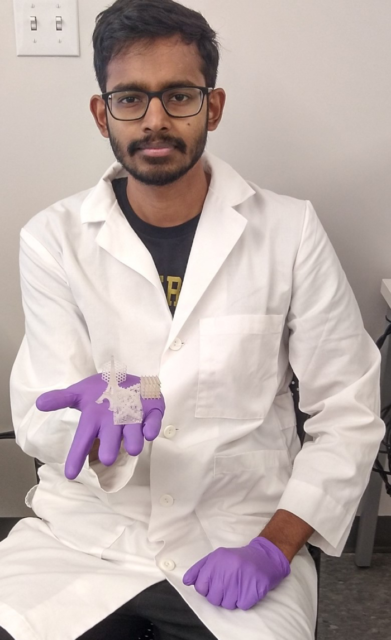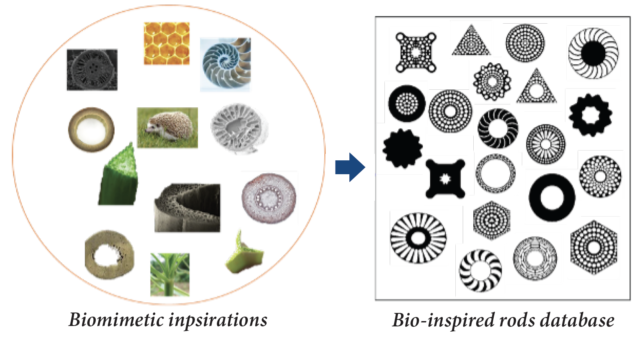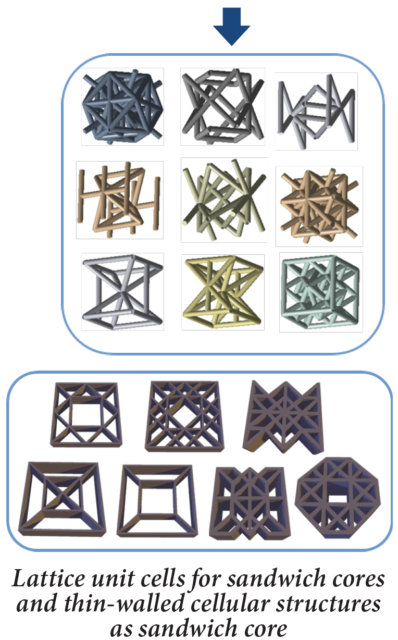LAMDA’s metamaterials research was featured in the latest Louisiana EPSCoR newsletter (View the newsletter as a PDF):
Natural structures inspire the design of new lightweight metamaterials
You wouldn’t expect to hear about hedgehogs and porcupines in a materials science research lab, but their spines and quills are very much of interest because they have superior resistance to buckling, while also being hollow and lightweight.
 Nature has perfected structure specialization in so many ways and researchers have realized that investigating new materials benefits greatly with “biomimetics,” which is the field of science that draws from biological processes and designs found in nature.
Nature has perfected structure specialization in so many ways and researchers have realized that investigating new materials benefits greatly with “biomimetics,” which is the field of science that draws from biological processes and designs found in nature.
The menu of nature’s finest engineering designs is extensive and the combinations of strengths and benefits are unlimited. For example, combine the buckling resistance of hedgehog spines, the strength-to-weight ratio of bamboo— which is very light and can withstand up to 52,000 pounds of pressure per square inch— and the tough scales of fish that provide vibration damping and streamlined hydrodynamics, and you could possibly design significantly stronger, lighter, faster, and more fuel-efficient aircraft fuselages, ship hulls, and car bodies.
Louisiana Materials Design Alliance (LAMDA) researchers are using biomimetics in the design of new structures that solve engineering problems relating to strength, weight, durability, and more. LAMDA is funded by a $20 million cooperative agreement with the National Science Foundation and support from the Louisiana Board of Regents.
Specifically, LAMDA researchers are designing “sandwich structures,” that are thin-walled cellular structures and lattice designs sandwiched between two thin outer skins. These composite materials are lightweight and strong due to the structure of the core of the sandwich, which can vary anywhere from a simple grid to complicated 3D shapes. The goal is to design new cores that can be used to manufacture the lightest and strongest sandwich structures.
Photo: Mr. Adithya Challapalli, LSU Ph.D. student, is holding several optimized lattice cores 3D printed using a TSMP ink.
But it doesn’t stop there. The team is researching lightweight structures with an extra feature of being made out of 3D printed Thermoset Shape Memory Polymers (TSMP). These highly specialized polymers are “smart” materials and have “shape memory,” the capability of returning to its original shape after being deformed or triggered by certain stimuli. This added smart property categorizes this class of new materials as “metamaterials.”
The challenge is that taking inspiration from nature and testing each design with classic numerical analysis techniques is a very time consuming endeavor due to the millions of possible structural combinations.
LAMDA Research Assistant and PhD student at LSU, Adithya Challapalli, is taking the TSMP design to the next level with machine learning. He developed a generative adversarial network (GAN) and regression analysis to discover the correlation between the microstructures and mechanical properties of biomimetic rods and then further optimized the biomimetic rods into lattice and cellular structures as a sandwich core. In addition, he developed a new inverse machine learning framework to speed up the process of discovering new metamaterials with superior properties.
“Mr. Adithya Challapalli developed a new inverse machine learning framework, and successfully discovered several new metamaterials with mechanical strength, natural frequency, and impact tolerance superior to their natural counterparts, such as honeycomb,” said Dr. Guoqiang Li. “Most interestingly, he discovered several new lattice structures and thin-walled cellular structures, 3D printed them using TSMP, and proved that these structures have record-high recovery stress. His inverse machine learning framework has a good potential to optimize other engineering structures and devices,” added Li.
Challapalli is in the last semester of his doctorate program, and is appreciative to Dr. Li, Major Morris S. & DeEtte A. Anderson Memorial LSU Alumni Professor and John W. Rhea, Jr. Professor of Mechanical Engineering at LSU, and Distinguished Research Professor at Southern University, for providing guidance and the freedom to explore different research ideas in this multidisciplinary field, and bringing together collaborators in material science, structural mechanics, and computer science.
“I believe the inverse design frameworks and machine learning techniques proposed through my research can be extended and be used as an alternative data-driven optimization technique. The lightweight structures discovered through these frameworks are much superior to previously designed structures in terms of load-carrying capacities, buckling and impact strengths, energy absorption and shape recovery properties with applications in aerospace, automobiles, naval vessels etc.,” said Challapalli.
Challapalli’s imminent completion of his PhD in Engineering Science with a Materials Science & Engineering concentration will be a great complement to his B.S. in Mechanical Engineering from India and M.S. in Mechanical & Energy Engineering from University of North Texas. He is currently looking for a job in the industrial sector as a mechanical designer or research and development engineer.
Figure: Step-by-step optimization by machine learning for discovering cores for lightweight sandwich structures.


